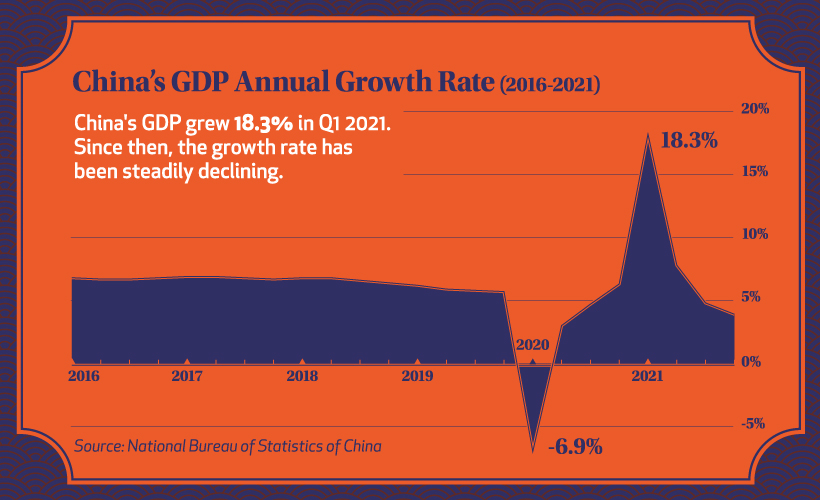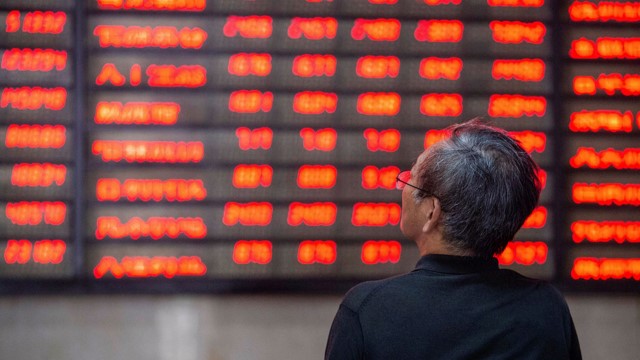After the United States, China is the world’s second largest economy, and it is predicted to overtake the United States in the next decades.
While China’s economy has had a rough start to the year due to zero-tolerance COVID-19 lockdowns and supply chain concerns, our visualization includes data for the entire year of 2021—a year in which most economies recovered from the pandemic’s initial disarray.
According to the National Bureau of Statistics, China’s Gross Domestic Product (GDP) hit 114 trillion dollars ($18 trillion in USD) in 2021. The country’s economy surpassed government expectations of 6% growth, expanding at an annual rate of 8.1 percent.
Let’s examine what drives China’s contemporary economy.
Breaking Down China’s Economy By Sector
| Sector | 2021 Total GDP (Yuan) | 2021 Total GDP (USD) | % Share |
|---|---|---|---|
| Industry | ¥37.3T | $5.9T | 32.6% |
| Wholesale and Retail Trades | ¥10.5T | $1.7T | 9.2% |
| Finance | ¥9.1T | $1.4T | 8.0% |
| Farming, Forestry, Animal Husbandry, and Fishery | ¥8.7T | $1.4T | 7.6% |
| Construction | ¥8.0T | $1.3T | 7.0% |
| Real Estate | ¥7.8T | $1.2T | 6.9% |
| Transport, Storage, and Post | ¥4.7T | $0.7T | 4.1% |
| Information Transmission, Software and IT Services | ¥4.4T | $0.7T | 3.9% |
| Renting & Leasing Activities and Business Services | ¥3.5T | $0.6T | 3.1% |
| Accommodation and Restaurants | ¥1.8T | $0.3T | 1.6% |
| Others | ¥18.1T | $2.8T | 15.9% |
| Total | ¥114T | ¥18T | 100.0% |
By far the most important driver of China’s economy is industrial production, which includes activity in the manufacturing, mining, and utilities sectors. The industry generated $37.3 trillion in 2021, accounting for one-third of the country’s overall economic output.
The wholesale and retail trades performed well in 2021, notwithstanding a downturn in December. At the end of the year, it was impacted by lockdown measures and the propagation of the COVID-19 Omicron variant, but it still increased by double digits, reaching a total of $10.5 trillion*.
In 2021, “other services,” which encompass everything from scientific research and development to education and social services, accounted for 18.1 trillion yuan, or 16 percent of China’s overall economy.
What is the future of china’s economy ?
Last year, China’s economy rebounded substantially quicker than most major nations, and the country has expanded regularly in previous years, as the overall trend below illustrates.

The country’s economy failed after the initial commencement of COVID-19, echoing economies around the world. However, after a robust recovery through 2021, resurgent instances prompted a fresh round of private-sector crackdowns, significantly slowing GDP growth.
With the downturn expected to last until early 2022, China’s economic future remains uncertain. The lockdown in Shanghai is set to last until June 1st, and hundreds of ships have been stranded outside of Shanghai’s port due to continuous supply chain issues in recent months.
Is Tech crackdown will harm china’s growth ?
in year 2021/2022 china punished their leading Tech companies for their data sharing with US SEC . These crackdown lead to massive drops in their valuation as of today Alibaba dropped as much as 60% from its high , tencent is at 46% and Didi is yet to find the bottom . While any experts believes that chinese tech stocks are ready to bounse back the future still remains shacky under these new crackdown laws.
Is China’s Zero-COVID Policy Beneficial or Harmful to the Economy?
While each country responded differently to the COVID-19 epidemic, China implemented a zero-COVID policy that included severe lockdowns to control cases and outbreaks.
The policy had little effect on GDP growth for the most of 2021. Despite the fact that some large cities were completely or partially shut down to contain regional outbreaks, the country’s economy outperformed many other major economies.
However, the appearance of the Omicron variety posed a threat to the approach. Despite nationwide lockdowns and an 88 percent vaccination rate, Omicron cases have been detected in seven of China’s 31 provinces and all of the country’s major cities.
And China’s zero-COVID policy has not affected all sectors equally. Industrial production rose by more than 10% in the first 11 months of 2021, despite city lockdowns around the country. That’s because many factories in China are in suburban industrial parks outside the cities, and employees often live nearby.
But many sectors like hotels and restaurants have been more severely affected by city lockdowns. Many global economies are starting to transition to living with COVID, with China remaining as one of the last countries to follow a zero-COVID policy. Does that ensure the country’s economy will continue to slow in 2022, or will China manage to recover and maintain one of the world’s fastest growing economies?





